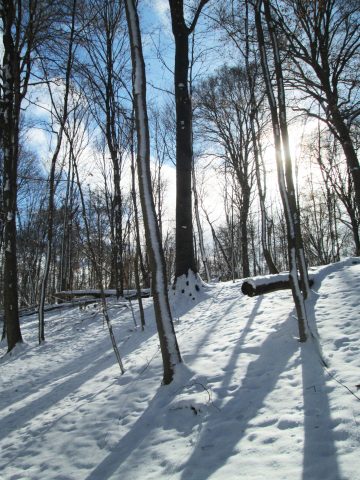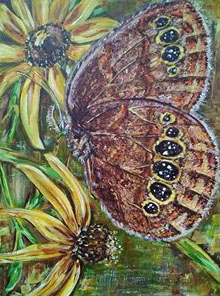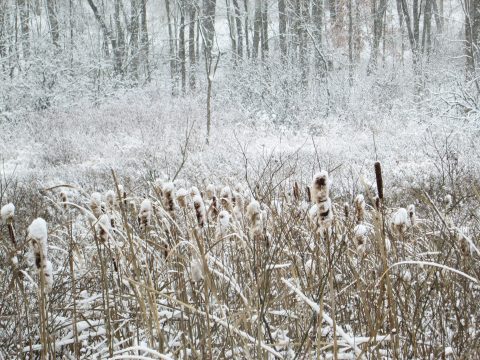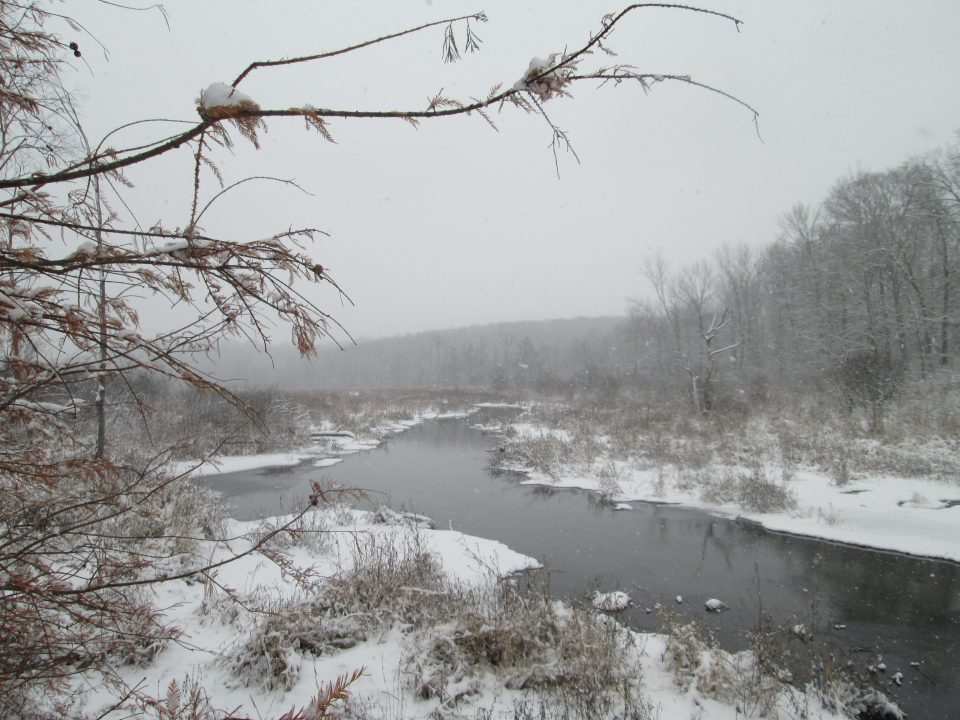
Today wind blows through cracks and sneaks down my collar. It brings snow and some of our first really cold weather, and the chill makes me think wise those creatures who choose to tuck themselves away in a cozy, secluded place a few strategic months every year. From the midst of a first-of-the-season shiver, hunkering down until the world regrows and re-greens makes a lot of sense.

How incredible that this present dormancy will swing back to production in just a few (or four) months! Such resurrection is often the topic of spring reflections, but as I swaddle myself in blankets, pile layers up to my nose, and generate warmth in kitchen and body with soup and tea, I’m thinking of … grub. Grubs and caterpillars, to be more precise: those least elegant of creatures that undergo a magical, seemingly impossible transformation while wrapped in darkness.
Here at Camp this time of year, the Mitchell’s satyr butterfly larvae merit special consideration. While many caterpillars hatch and pupate in one season, the Mitchell’s satyr caterpillars hibernate through the winter, then emerge in the spring to make a cocoon, transform, and commence their new life. This means that on top of their already magical transformation, the Mitchell’s satyr caterpillars somehow survive winters in the northern Midwest – without fur, without a den, without cuddling companions.

Unless you happen to know a little bit about the Mitchell’s satyr and its life stages, the butterfly is remarkably unremarkable. It’s diminutive in stature (wingspan under two inches), dull-ish in coloration (mostly brown), and prefers to hang out on hum-drum sedges. It doesn’t even fly very well. Looking past these wing-deep qualities, though, the Mitchell’s satyr is nothing short of inspirational.
The Mitchell’s satyr butterfly, according to the Michigan Department of Natural Resources, is “one of the world’s rarest butterflies,” and is found in only about 13 locations, all of which are in Michigan and Indiana. It lives only in prairie fens, a unique wetland ecosystem occurring in glaciated regions of the upper Midwest (such as southern MI), and lays its eggs on native sedges that are threatened by invasives, like cattails. As prairie fens have been drained and developed for agricultural or residential use, the Mitchell’s satyr has been disappearing, too.

Camp Friedenswald is fortunate to host a Mitchell’s satyr population in the fen here, and is working with several partners on a conservation plan. Habitat conservation is key, and requires long-range vision. About five years ago Camp started restoration of the prairie now near the tennis courts – a many-step project that itself was only one component of improving Mitchell’s satyr habitat. In addition to filling its own important niche, the prairie was intended as a land bridge to encourage the spread of the Mitchell’s satyr between east and west fens. Restoration required removing the top layer of soil from the prairie-to-be, tilling the ground, then seeding with native grasses and wildflowers. Now, with native plants reestablished, Camp staff conduct periodic controlled burns to simulate the naturally-occurring fires that maintained prairies in the past.

While some butterflies take about a month to develop from chubby caterpillar into brilliant-being-of-light, the satyr’s larval stage is much longer, lasting through these chilling winter months. Their unique and extended life cycle makes conservation efforts more complicated, and more precarious. Recent efforts to hatch eggs to introduce at Camp failed for reasons that aren’t totally clear, so efforts will need to start over again, but people involved with Mitchell’s satyr conservation are up to the task. Considering the local and statewide involvement with Mitchell’s satyr projects, it’s clear that one inspirational aspect of the Mitchell’s satyr is the collaborative action the species has motivated.

I warm my hand over a mug of tea, wonder what sort of craziness enables the Mitchell’s satyr caterpillars to survive hunkered down in the dark earth beneath the snow, and can easily see why butterflies have been linked with the supernatural in mythologies worldwide. Before transforming into the weightless, ephemeral creatures that elicit notions of liberation from our cumbersome, demanding bodies and minds, they exist as caterpillars: so humble, voracious, and even sort of repulsive, that relation to their own self seems impossible. As I beckon spring before winter’s even begun, the Mitchell’s satyr caterpillar waits, through cold, through darkness and short days. When the time is right, it will transform energy from its weighty ways into flight. Inspirational? Absolutely. As conservation efforts continue at Camp and throughout the state, may our position as a host for the Mitchell’s satyr butterfly help us to be mindful: of inspiration in humble wrappings, and of the change that can come with persistence.
References used:
State of Michigan. (2017). Mitchell’s satyr (Neonympha mitchellii mitchellii). Retrieved from Michigan Department of Natural Resources: http://www.michigan.gov/dnr/0,4570,7-153-10370_12145_12204-33013–,00.html
US Fish & Wildlife Service. (2017, accessed). Mitchell’s satyr fact sheet. In Endangered species. Retrieved from https://www.fws.gov/midwest/endangered/insects/misa_fctsht.html